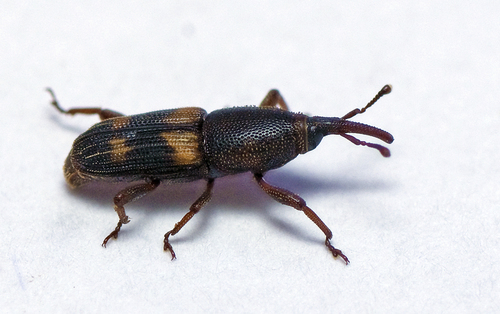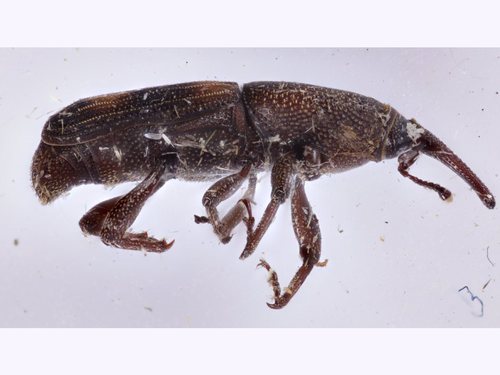Lesser Coconut Weevil
Diocalandra frumentiDiocalandra frumenti 4
Contents
Distribution
Diocalandra frumenti is found in Somalia, Tanzania, Madagascar, the Seychelles, Mauritius, India, Sri Lanka, Bangladesh, Myanmar, Malaysia, Singapore, Indonesia, the Philippines, Japan, Taiwan, Papua New Guinea, various Pacific island groups and Australia. It has also been recorded in the Canary Islands.[5][6] Although infesting a number of species of palm, it is a major pest of coconut (Cocos nucifera), oil palm (Elaeis guineensis), Canary Island date palm (Phoenix canariensis), date palm (Phoenix dactylifera), California fan palm (Washingtonia filifera) and Mexican fan palm (Washingtonia robusta).[7]Life cycle
The adult Diocalandra frumenti is about 7 mm (0.3 in) long. It is a glossy black colour with four large rusty-brown or blackish-brown coloured spots on the elytra (wing covers}. The female lays eggs in crevices in the stems of palms which hatch in about a week. The larvae bore into the stem where they form extensive galleries. After eight to ten weeks they pupate, the adult emerging from the pupal case about eleven days later.[8]
Damage
Eggs may be laid among the flowers, in cracks in the leaf or flower stalks, or near the base of the stem just above the adventitious roots. As the larvae bore deeper into the palm, a gummy exudate forms in the entry hole. The galleries can damage any part of the palm including the roots. Leaves may turn yellow and fruit may drop off, and severe infestations may cause the plant to die.[8] It has been found that the males emit a pheromone which attract females, and this may make it possible to trap the insects, which are strong fliers, and reduce the level of infestation. The weevil has a number of natural enemies including a parasite Spathius apicalis, a predatory fly Chrysophilus ferruginosus and a predatory beetle Plaesius javanus.[9]
References
- ^Global Biodiversity Information Facility: Diocalandra frumenti Marshall & G.A.K., 1931 (retrieved 9 January 2020)
- ^"Diocalandra frumenti (Fabricius, 1801): lesser coconut weevil". Discover Life. Retrieved 30 November 2019.
- ^"Diocalandra frumenti (palm weevil borer)". UniProt. Retrieved 30 November 2019.
- ^Vacas, S.; Navarro, I.; Seris, E.; Ramos, C.; Hernández, E.; Navarro-Llopis, V.; Primo, J. (2017). "Identification of the Male-Produced Aggregation Pheromone of the Four-Spotted Coconut Weevil, Diocalandra frumenti". Journal of Agricultural and Food Chemistry. 65 (2): 270–275. doi:10.1021/acs.jafc.6b04829. hdl:10251/101790.
- ^"Diocalandra frumenti: distribution". EPPO Global Database. Archived from the original on 5 December 2019. Retrieved 30 November 2019.
- ^Lu Xiu-xia (2003). "The dangerous palm weevil borer, Diocalandra frumenti (Fabricius), and its morphological differences with related species (Coleoptera:Curculionidae)". Forest Pest and Disease. 6.
- ^"Diocalandra frumenti: hosts". EPPO Global Database. Archived from the original on 5 December 2019. Retrieved 30 November 2019.
- ^ abHoward, F.W.; Giblin-Davis, R.; Moore, D.; Abad, R. (2001). Insects on Palms. CABI. p. 287. ISBN978-0-85199-705-6.
- ^Lever, R.J. (1969). Pests of the Coconut Palm. FAO. pp. 122–123. ISBN978-92-5-100857-7.
Sources and Credits
- (c) tjeales, some rights reserved (CC BY-SA), uploaded by tjeales
- (c) Graeme Cocks, some rights reserved (CC BY-NC-SA), uploaded by Graeme Cocks
- (c) valryr, some rights reserved (CC BY-NC), uploaded by valryr
- Adapted by monkeyjodey from a work by (c) Wikipedia authors and editors, some rights reserved (CC BY-SA), http://eol.org/data_objects/28255481









